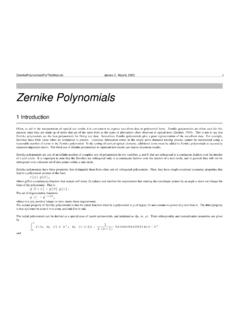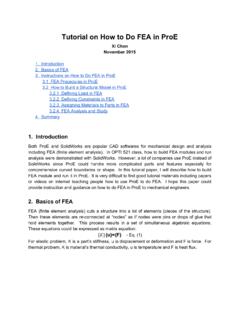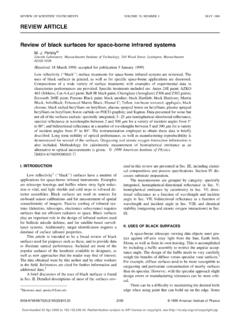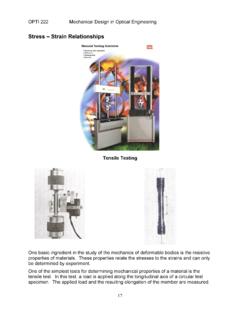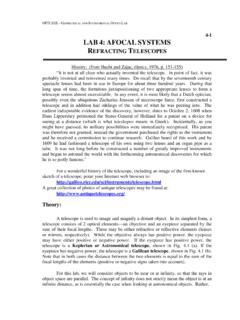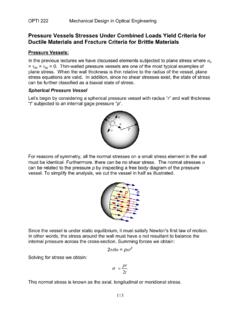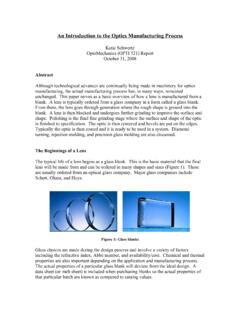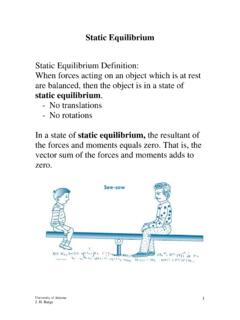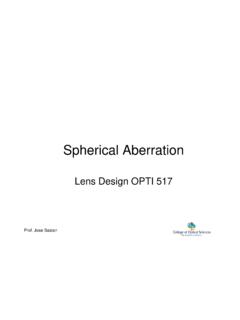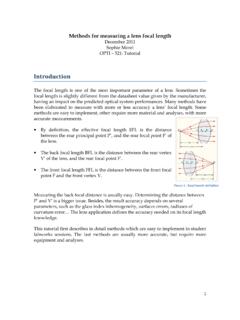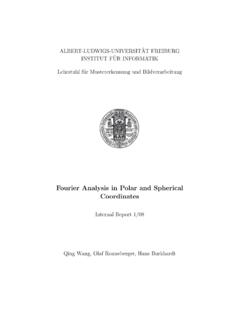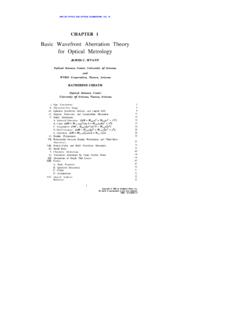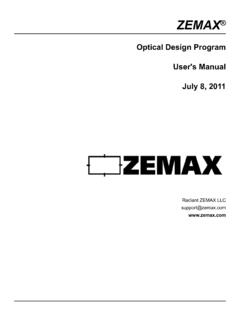Transcription of Introduction to ISO 10110 - University of Arizona
1 Introduction to ISO 10110 Preparation of drawings for optical elements and systemsand a few words about other optical standardsParts of ISO Differences between optical and mechanical imperfections Stress birefringence 0 imperfections Bubbles and inclusions 1 imperfections Inhomogeneity and striae 2 form tolerances 3 tolerances 4 imperfection tolerances 5 treatment and representing data of a lens irradiation damage thresholdSimple optical element drawingPart 2 Material imperfections Stress birefringenceIndication in drawing 0/X where X is the max. birefringence in nm/cmOPD due to stress birefringence = a* *K wherea = sample path length in cm = residual stress in N/mmK = difference in photoelastic constants in 10-7mm/NA retardation > 20 nm/cm corresponds to a coarse annealA retardation of < 10 nm/cm is referred to as fine annealPart 3 Imperfections Bubbles and inclusionsIndication in drawing 1/NxA whereN is the number of allowed bubbles or inclusionsA is the length of the side of a square in units of mm(Thus A^2 is the area the bubble or inclusion obscures)The obscured area may be sub-divided into smaller bubbles provided the obscured area is no larger than that designated.
2 Table shows an exampleA typical designation might be 1 same system of designation is used for surface defects inPart 7 Part 4 Imperfections Inhomogeneity and striaeIndication in drawing 2/A;B where A is the class number for inhomogeneityB is the class for striaePart 5 Surface form tolerancesIndication in drawing 3/A(B/C)where A is the maximum spherical sag error from test plateor a dash (-) where the radius tolerance is a dimensionB is the p-v maximum irregularityC is the maximum rationally symmetric p-v figure errorThe units are fringes (or fringe spacings)There is a provision for RMS specification in fringesPart 6 Centring tolerancesIndication in drawing 4/ where is the angle between the datum and surfaceThe indication is always the same for each surface but the method of indicating the datum follows mechanical drawing practiceA polished surface can be a datum and is often the best choice of datumPart 7 Surface imperfection tolerancesIndication in drawing 5/NxAWhere N is the number of allowed imperfectionsA is the length of the side of a square in mmso NxA^2 is the total area obscured by imperfectionsCoating imperfections are preceded by a CLong scratches by an LEdge chips by an ESub-division is permissible the same as with bubbles and inclusionsExample 5/NxA; CN xA.
3 LN xA , EA Part 8 Surface textureIndication on drawing-Type of textureType of measurement andMagnitude Scan lengthType of texture G for ground or matt, P for polishedType of measurement Rq, RMS or PSD (Power spectral density)Scan length and increment minimum resolution and scan distancePart 9 Surface treatment and coatingIndication on drawing - for optical thin film coatingsSymbol touches surface or extension line from surface affectedDraw a leader from symbol to box containing coating specificationISO 9211 Optical coatings explains coating specificationsUnless otherwise stated wavelength is assumed nmEdge blackening or protective coating indicated by thick chain line (line type J, ISO 128) adjacent to the applicable surfacePart 10 Table representing data of a lens element Shows the simple element drawing shown at beginning Table 1 is useful check list to see if drawing is complete Also a quick summary of the symbols used in optical drawings Several examples of lens element drawingsPart 11 Non-toleranced dataPart 12 Aspheric surfaces Just the sag formulas in most lens design software One comment on zernike polynomials The standard uses the FRINGE monomial p-v ordering I think this is short sighted You should use double indices as in Where I is the power of the radial parameter.
4 And j is the angular orderji Part 13 Laser irradiation damage threshold Here to let you know this part exists Has commercial use for lasers used in processing materials These days commercial lasers powerful enough to damage coatings Just looked at ISO 10110 There are over 200 ISO optical standards dealing with Coatings Environmental tests Microscopes, telescopes, endoscopes and ophthalmics Laser devices Optical materials and glasses Vocabulary and definitions More are being added all the time Also there is a whole body of Mechanical standards TR 5460 is great on GDT The US participates in the standards writing The standards are copywritten material Proceeds from their purchase supports standards writing efforts
